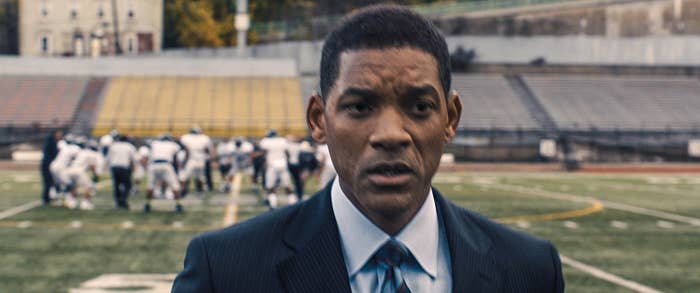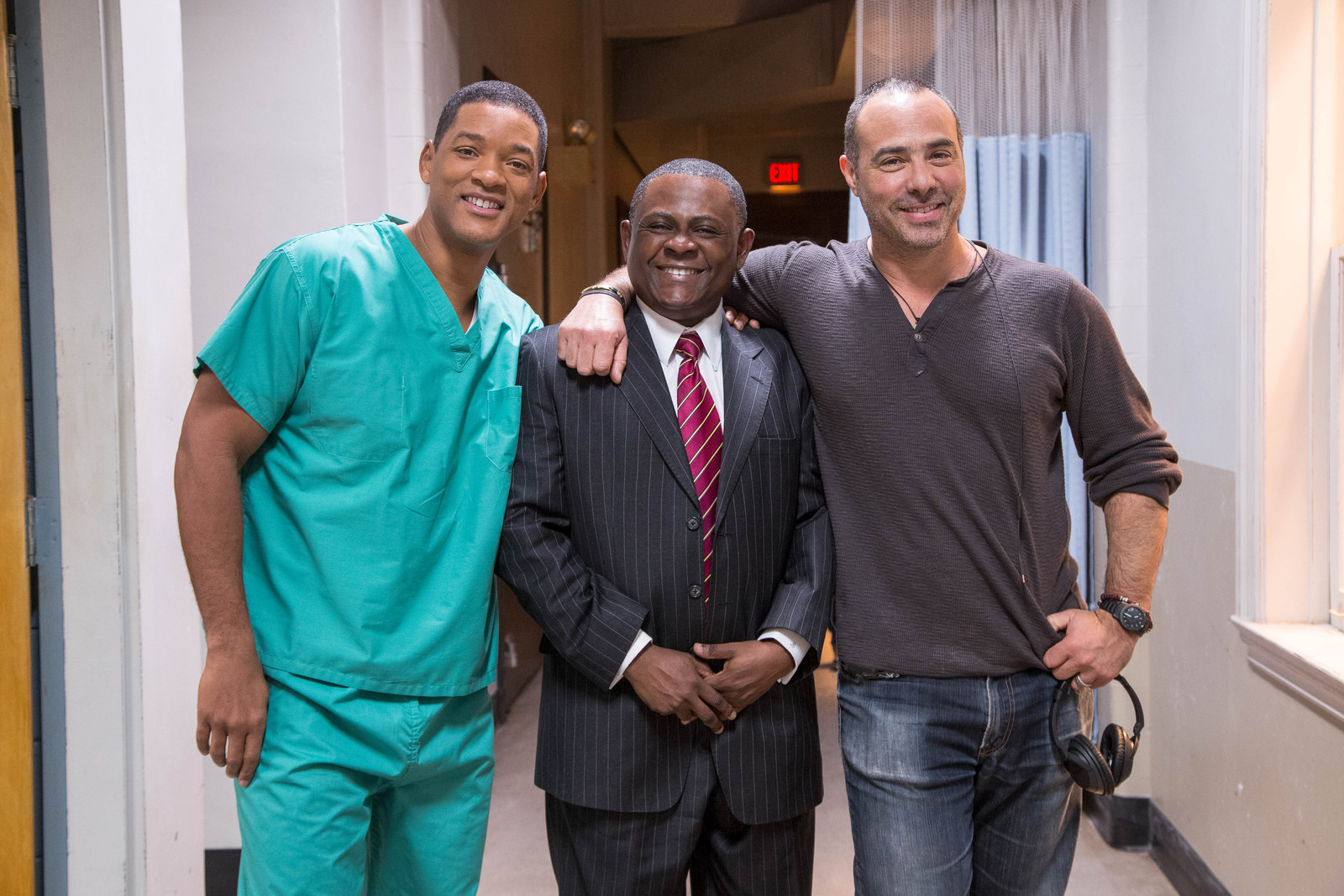
Forty minutes into Concussion, Dr. Bennet Omalu, played by Will Smith, turns to his future wife, Prema Mutiso, played by Gugu Mbatha-Raw, and tells her: “God did not intend for us to play football.”
Sitting on the couch in their apartment, watching a clip reel of NFL hits and falls on a small television in front of them, Omalu shows Mutiso a peach in a mason jar full of water that is meant to represent the way human brains float unprotected in our skulls. He shakes the jar back and forth, punctuating each motion to indicate separate hits. The peach begins to break down, and the camera toggles back to NFL footage.
Concussion is Sony’s upcoming adaptation of the true story of Omalu, a Nigerian-born neurologist, who discovered chronic traumatic encephalopathy — or CTE, a degenerative brain disease — in beloved Pittsburgh Steelers center Mike Webster.
The discovery led to the revelation that the NFL worked to conceal brain injuries caused by playing football, plunging the league into a public relations and legal crisis. The film is based on “Game Brain,” a 2009 GQ story by Jeanne Marie Laskas — credited as a screenwriter for Concussion — that told how the NFL tried to discredit Omalu’s research and intimidate him into retracting his findings.
Though not in the credits, the story clearly draws heavily from League of Denial, the 2013 book by ESPN investigative reporters Mark Fainaru-Wada and Steve Fainaru. Omalu’s language in some Concussion scenes is drawn directly from the book, which was adapted into a PBS Frontline documentary in 2013.
When Sony’s emails were hacked and uploaded online in 2014, the NFL pushed back hard on Sony executives — who were meticulous in making the film airtight “in its representation of the “science and history.”
That revelation led to concerns that Concussion would water down the NFL’s treatment of Omalu — this was, after all, a story the NFL did not want to be made public. But, for the most part, that didn’t happen when it came to the final product: Concussion is unflinching in its portrayal of the CTE crisis. And attention on the disease will only pick up steam after Wednesday's revelation that NFL legend Frank Gifford suffered from it.
To borrow a line from the film — spoken by Allegheny County Coroner Cyril Wecht, played by Albert Brooks, to Omalu — “The league has kept everyone in the dark, and you’ve turned on the lights and given its biggest boogeyman a name.”
Concussion, out Christmas Day, does just that.

The film begins with an adaptation of a speech Webster (played by David Morse) delivered during his induction into the Pro Football Hall of Fame in 1997. The role of the center on an offensive line is both cerebral and physical: He makes the decision on how his fellow linemen should be set, snaps the ball to the quarterback with precision, and then an instant later blocks defensive linemen from the most central route to the passer.
Webster is then shown — years later — ragged and living out of his truck in an industrial corner of Pittsburgh, homeless and away from his wife and family. To put himself to sleep, he sniffs ammonia and tasers himself repeatedly in the leg. He visits Dr. Julian Bailes (played by Alec Baldwin), a former Steelers team neurosurgeon, and confronts him violently, telling him he can’t control the demons in his head and he needs a cure. Bailes tranquilizes Webster, looking at him with sympathy, but without a solution.
Webster died in 2002 at age 50, only five years after his Hall of Fame induction. Omalu was the pathologist on shift at the Allegheny County Coroner’s Office the day Webster’s body came in. A throng of fans and reporters showed up at the office with Omalu, perhaps one of the few Pittsburghers who knew nothing of Webster’s 17-year NFL career.
Smith plays a convincing role, though his heavy accent has been criticized as a generic mix of sub-Saharan accents. Omalu’s Nigerian heritage is used in the film to tell the story of a man pursuing the American dream, but what mostly helped Omalu hold the NFL accountable, noted in Concussion, is his status as an outsider. Football is an inextricable part of modern American culture. But Omalu harbored no love for or knowledge of the game, allowing him to pursue the science without personal conflict.
Examining Webster’s body on a coroner’s table, Omalu looks at the former NFL star and says to him: “I need your help to tell the world what happened to you.”
When Omalu examines Webster’s brain, he sees no signs of abnormality, which strikes him as absurd. The man had been acting as if he had dementia in his forties, and Omalu knew there was no pre-existing literature on the condition that led to Webster’s death. Against the discouragement of his colleagues, and on his own dime, Omalu dissects Webster’s brain and takes slides of internal matter and examines it at his own kitchen table.
He focuses on what appears to be splotchy neural matter to the untrained eye — but in the slides he sees something the film does not name, but is now known as “tau proteins,” which should not be found in the segment of the brain Omalu observed. He paces, contemplating his discovery, as shots of Webster’s football career flash in his mind. The discovery, publishing, and naming of the disease are presented in a gripping 15-minute portion of the film, complete with dramatic music and aerial shots of Heinz Field. Omalu called it chronic traumatic encephalopathy, and he was excited to share his knowledge with the world.
This is how researchers at Boston University (where there is now a CTE Center led by top researchers in the field) define CTE:
“A progressive degenerative disease of the brain found in athletes (and others) with a history of repetitive brain trauma, including symptomatic concussions as well as asymptomatic subconcussive hits to the head. CTE has been known to affect boxers since the 1920s. However, recent reports have been published of neuropathologically confirmed CTE in retired professional football players and other athletes who have a history of repetitive brain trauma. This trauma triggers progressive degeneration of the brain tissue, including the build-up of an abnormal protein called tau. These changes in the brain can begin months, years, or even decades after the last brain trauma or end of active athletic involvement. The brain degeneration is associated with memory loss, confusion, impaired judgment, impulse control problems, aggression, depression, and, eventually, progressive dementia.”
A recent report by Frontline said that CTE has been found in the brains of 87 of the 91 former NFL players examined by the Department of Veterans Affairs and Boston University. It’s a non-scientific sample size and the disease can only be diagnosed postmortem; it does not show on a CAT scan.
Concussion sticks closely to story reported in “Game Brain” and League of Denial, editorializing infrequently but effectively. The science of CTE is simplified, but portrayed accurately. Director Peter Landesman benefited from the compelling nature of the true story but struggled to capture the full context of the disease and subsequent crisis in a tidy two hours. Concussion is not the story of CTE in full, but it will be an impactful elevation of the science and silence behind the crisis in public consciousness.

When the NFL was made aware of Omalu’s science, they first tried to discredit it by presenting conflicting information from doctors who were not trained neurologists, and then attempted to intimidate Omalu into silence. The league denied any connection between their sport and the prevalence of CTE in its former players.
In a scene in the Coroner’s Office, Dr. Wecht is straight with Omalu, who still struggles to understand why the NFL would not prioritize the safety of its players:
“Bennet Omalu is going to war with a corporation that has 20 million people on a weekly basis craving their product. They own a day of the week: the one that the church used to own.”
Throughout the film, Omalu makes as many allies as enemies. Dr. Bailes, the former Steelers trainer who saw Webster before his death, enthusiastically joins Omalu. The two men try to recruit Dr. Joe Maroon (Arliss Howard), a neurosurgeon who has been a member of the NFL’s Head, Neck and Spine Committee since 1994, to their cause after he tries personally to scare off Omalu. Maroon struggles with a foot in each camp — the NFL and science — but explains the NFL’s central fear of Omalu’s research: “If only 10% of mothers in America begin to conceive of football as dangerous, that is the end of football.”
The same quote was attributed to Maroon in League of Denial. The pipeline to the NFL will dry up without youth football, Maroon asserts.
One day at home, Omalu receives a phone call from a man who appears to be a football fanatic, but is not explicitly connected to the NFL: “You wanna puss-ify this country?” the irate fan asks, echoing the legions of fans who associate player safety with an apparently offensive feminization of sport culture. “You wanna vaginize it? Get the hell out, or it’ll be your autopsy.”
Intimidation tactics against Omalu and his family from the NFL and fans are used to show Omalu’s perseverance and confidence in his work. But by the end of the film, Omalu has received some recognition and the NFL has begun to realize the story of their players’ health is no longer in their control. The American dream narrative that follows Omalu through his research and battle with the NFL concludes neatly, but with a heavy hand.
When Concussion is released, the NFL will be in the prime of its season — just about to wrap the regular season and head into the playoffs, punctuated by Super Bowl 50 in the league’s shiniest new stadium in Santa Clara, California. For many avid football fans, the story of the CTE crisis as presented in Concussion is not new or revelatory. But for many fans, Concussion will be the light that shines on the NFL’s darkest spot.
Concussion will certainly change more than a few minds and hearts on the moral value of watching football on Sundays, and the NFL was right to be concerned about its release.
CORRECTION
“Game Brain” is the name of Jeanne Marie Laskas's 2009 GQ story that inspired Concussion. An earlier version of this post misstated its title.
